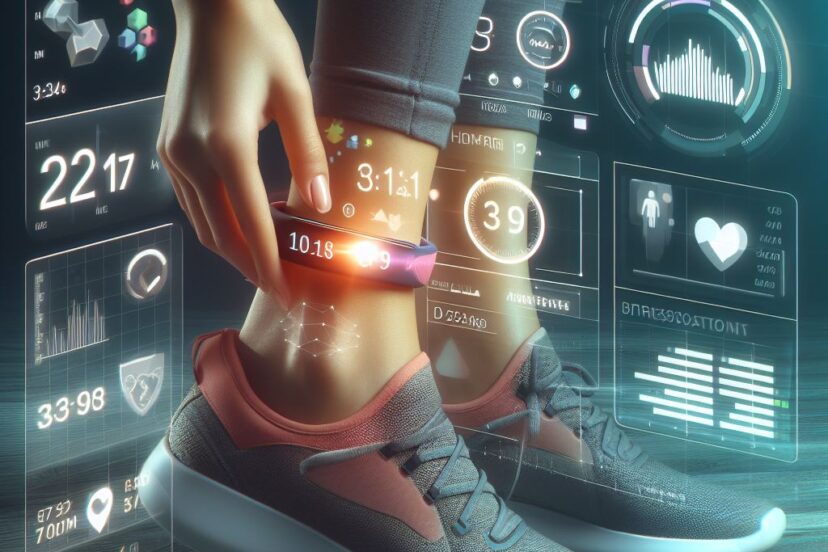Ankle Fitness Tracker: Enhancing Your Workout Routines
*We may earn a commission for purchases made using our links. Please see our disclosure to learn more.
Ankle Fitness Tracker: Enhancing Your Workout Routines with Precision Tracking
Fitness trackers have become an indispensable tool for those looking to monitor and enhance their physical activity. These devices offer a comprehensive view of your health by tracking various metrics such as step count, heart rate, and even sleep patterns. Among the various types of fitness trackers, the ankle fitness tracker stands out for those who prefer a device that is discreet and specifically oriented towards activities like running, cycling, and swimming, where wrist movements are minimal.
Ankle fitness trackers are designed to fit comfortably around the ankle, providing a more accurate reading for lower-body activities and reducing wrist clutter for those who may already wear a watch or other wrist accessories. They can be especially beneficial for runners who want to measure stride length or for swimmers looking for a waterproof option that won’t interfere with their movements.
When considering the purchase of an ankle fitness tracker, durability, comfort, accuracy, and water resistance are some of the critical factors to take into account. The material of the strap should be gentle on the skin while ensuring the device stays in place during rigorous activities. Furthermore, the device’s compatibility with various apps and its battery life are aspects that can influence user experience and satisfaction.
Investing in an ankle fitness tracker can be a game-changer for those who are serious about tracking their performance in specific sports or simply want to free up their wrists. I’ve researched and analyzed several ankle fitness trackers to help you find one that not only fits your needs but also enhances your fitness journey.
Top Ankle Fitness Trackers
I’ve spent ample time researching and analyzing the performance of various ankle fitness trackers to assist you in finding the best options on the market. These trackers are specifically designed to comfortably wrap around your ankle, providing accurate activity data without encumbering your wrist. Whether you’re a runner seeking to monitor your strides or someone looking to track daily movement patterns discretely, the following devices offer reliable metrics and user-friendly features to enhance your fitness journey.
Fitbst Ankle Band
I found the Fitbst Ankle Band to be a reliable accessory for capturing accurate step counts, particularly during activities where wrist-worn trackers fall short.
Pros
- Heightens step-tracking precision for non-arm swinging activities
- Feels lightweight and unnoticeable on the ankle throughout the day
- Versatile, fitting a wide range of compatible fitness trackers
Cons
- Must transfer the tracker from a wristband to the ankle band
- Limited aesthetic appeal compared to wristbands
- Not suitable for monitoring heart rate
Attempting a bike ride with the Fitbst Ankle Band in place, I immediately appreciated the band’s snug fit and forgettable presence on my ankle. The velcro adjustment made it simple to secure without any worry of it sliding down or feeling too restrictive.
During a trip to the supermarket, I noticed my strides were being recorded more faithfully than when my tracker was on my wrist. I pushed a cart around and the band’s mesh pouch kept my device safely tucked away, counting every step accurately.
After several sessions of various activities, from pushing strollers to brisk walks, I concluded that the ankle band true to its purpose. Machine washing it proved hassle-free, and it maintained its integrity without issue. Its discreet design, while not fashion-forward, meant that it never drew unwanted attention.
B-Great Ankle Tracker Band
I recommend the B-Great Ankle Tracker Band for those wanting to ensure they don’t miss a single step throughout their day, especially during workouts or errands.
Pros
- Securely stores various trackers without slippage
- Comfortably fits a range of ankle sizes with adjustable snaps
- Soft, lightweight material barely noticeable during use
Cons
- Limited to certain tracker models, not universally compatible
- Mesh pouch may wear out with intense, long-term use
- Heart rate tracking could be less reliable on the ankle for some devices
I recently gave the B-Great Ankle Tracker Band a try while jogging on the treadmill and found it incredibly easy to forget I was wearing it. Its soft, lightweight fabric meant no chafing – a huge relief for longer sessions. I wrapped it around my ankle, snapped it into place, and it didn’t budge throughout the entire run.
During a trip to the supermarket, it proved its worth yet again. Pushing a cart typically makes wrist-mounted trackers useless, but with the B-Great Band on my ankle, every step counted. The tracker stayed secure within the mesh pouch, even as I maneuvered through crowded aisles.
Clean-up post-workout was also hassle-free. The band is man-made, and that speaks to its durability – it held up well under a basic rinse. An added bonus is that it’s discreet enough to be worn under trousers, ensuring step count doesn’t stop at the gym doors. Enjoy finding a tracker-friendly solution that blends seamlessly with your day-to-day routine? The B-Great Ankle Tracker Band might just be what you need.
Fitbit Inspire 2 Tracker
If you’re aiming to enhance your fitness journey with comprehensive tracking features, the Fitbit Inspire 2 is a solid choice that delivers.
Pros
- Comprehensive health tracking that encourages an active and well-monitored lifestyle
- Impressive 10-day battery life minimizes frequent charging interruptions
- Water resistance adds a layer of convenience for swimming or showering
Cons
- Lacks built-in GPS, which may deter serious runners and cyclists
- The touch screen can be finicky when swiping through menus and stats
- A Google account is required, potentially an extra step for non-Google users
My experience with the Fitbit Inspire 2 has been largely positive, as it has proven to be a reliable companion in my quest for better health. The device’s all-day tracking features provide valuable insights, especially the Active Zone Minutes which push me to amp up the intensity during workouts. Its slim design never felt bulky on my ankle, which is a huge plus for someone like me who prefers wearables that are discreet.
The battery life is exceptional. With moderate use, including tracking workouts and sleep, I found myself charging the device less often, about once every ten days. This resilience means I’m not constantly worrying about the battery dying mid-run or in the middle of a busy day.
Swimming with the Fitbit Inspire 2 reassured me of its durability and has been an effortless experience. Being able to keep it on in the shower saves me from the hassle of taking it on and off throughout the day.
However, the absence of a built-in GPS meant I often carried my smartphone to track my routes during outdoor workouts—a minor inconvenience but worth noting for those who prefer to travel light. Additionally, occasional difficulties with the touch screen when navigating the device could interrupt the flow of my day. While not a deal-breaker, it’s an area where I’d love to see improvement.
Lastly, the requirement of a Google account for app usage might not sit well with everyone, mainly due to privacy preferences or the extra steps involved in setting up an account if you don’t already have one.
In summary, the Fitbit Inspire 2 is a fitness tracker that confidently ticks most boxes for everyday health monitoring. Its standout features like prolonged battery life, extensive health metrics, and water resistance make it a trustworthy tool for anyone serious about keeping tabs on their fitness progress.
Grestun Ankle Band
I found that the Grestun Ankle Band offers a surprisingly comfortable and practical alternative to wrist-based fitness tracking, especially for activities that require free wrists.
Pros
- Enhances comfort during workouts with wrist constraints
- Effortless to install and adjust, stays secure
- Breathable material minimizes sweat buildup
Cons
- Not as discreet as wrist wearables
- Could be a snug fit for larger ankles
- Velcro longevity in question with frequent adjustments
Having used the band during my kickboxing sessions, I immediately noticed the convenience it brought to my routine. The anxiety of potentially damaging my wrist-worn Fitbit vanished as the tracker settled securely on my ankle. Through an hour of intense movement, not once did the band slip or loosen, thanks to its reliable hook-and-loop fastener.
In day-to-day use, the tracker’s presence on my ankle was a non-issue. The band’s breathable fabric meant I scarcely felt it throughout the day, whether I was sitting at my desk or running errands. What stood out was the fact that my step count seemed more accurate, as the device now picked up movements that are typically missed when worn on the wrist.
However, it’s worth noting that the band is clearly visible, contrasting the subtlety of wrist wearables. For those who prefer their trackers unseen, this might not be ideal. Moreover, individuals with larger ankles should double-check the measurements, as the fit might be tight. Lastly, I wonder about the band’s longevity, specifically the Velcro, which could wear out with repetitive opening and closing.
NESKLA Simple Step Tracker
I recommend this device for those who prefer straightforward functionality in step tracking without the need for complex gadgets.
Pros
- Uncomplicated design, no unnecessary features
- Clips securely to clothes and offers a clear display
- Long battery life reduces maintenance hassle
Cons
- Lacks advanced features like connecting to an app or Bluetooth
- Not suitable for detailed fitness tracking beyond steps
- Potential limitations for tech-savvy users who desire syncing capabilities
After clipping the NESKLA tracker to my ankle, I appreciated its minimalism. There’s a refreshing simplicity in not battling with apps or Bluetooth connections—just clip and go. Its single-button reset works like a charm, resetting my count after a long day of walking without any fuss.
This step tracker’s display was remarkably easy to read. Despite running errands all day, a quick glance down at my ankle provided me with immediate step count updates without the need to squint or search for my reading glasses.
The substantial battery life of this gadget impressed me. It’s been weeks, and I’ve had no interruptions in tracking my daily activity. It doesn’t need daily charging or regular battery replacements, which is a relief. The NESKLA Step Tracker keeps things simple, letting me focus more on my activity and less on the tech.
Buying Guide
When selecting an ankle fitness tracker, I prioritize certain features to ensure I’m making the best choice for my needs. It’s crucial to consider device compatibility, comfort, battery life, and the specific metrics it tracks.
Compatibility
My fitness tracker must be compatible with my smartphone or computer. I look for devices that support both iOS and Android, or offer a platform-independent web service, to ensure seamless integration with my existing tech ecosystem.
- Operating System – iPhone or Android
- Connectivity – Bluetooth, Wi-Fi, or ANT+
Comfort and Design
Since I’ll be wearing the device continuously, comfort is non-negotiable. It should be made of skin-friendly materials and be adjustable to fit securely on my ankle without causing irritation.
- Material – Hypoallergenic, breathable
- Adjustability – Velcro or clasps for a snug fit
Battery Life
I prefer a tracker with long battery life to avoid daily charges. I aim for devices that offer at least a week of battery life on a single charge.
- Battery Duration – 5+ days
- Charging Method – USB or wireless charging
Metrics Tracked
I consider what data is important for my fitness goals. An effective tracker should cover basics like steps and calories, and possibly include advanced metrics like sleep quality and heart rate.
- Basic Metrics – Steps, distance, calories burned
- Advanced Metrics – Heart rate, sleep analysis, swimming laps
In summary, I look for a compatible, comfortable tracker with long battery life that provides detailed insights into my activity patterns. Using this approach, I can find an ankle fitness tracker that aligns with my fitness journey and lifestyle preferences.
Frequently Asked Questions
In this section, I will address some common inquiries about ankle fitness trackers, focusing on their benefits, accuracy, and features compared to wrist-worn devices.
1. What are the benefits of using an ankle fitness tracker compared to a wrist-worn device?
Ankle fitness trackers often provide a more accurate count of steps and distance when jogging or walking, as they are closer to the pivot point of leg movement. They can also be more comfortable for continuous wear and less obtrusive during daily activities.
2. How does the accuracy of an ankle-worn fitness tracker compare to traditional wrist-worn models?
Ankle-worn fitness trackers typically offer superior accuracy for certain activities like running or cycling, due to their position on the body. The lower limb movement is more consistent and can be measured directly, reducing the potential for motion-related inaccuracies that wrist models might encounter.
3. Which brands offer the best ankle fitness trackers for women?
Brands like Fitbit and Garmin have developed a reputation for providing high-quality ankle fitness trackers tailored to women. They offer devices with a range of features, sizes, and styles that cater to different preferences and needs.
4. Can a fitness tracker designed for the ankle monitor swimming activities effectively?
Yes, many ankle fitness trackers are designed with water resistance and can monitor swimming activities efficiently. They track metrics like laps, strokes, and distance, offering a comprehensive overview of swimming performance.
5. How do fitness trackers worn on the ankle perform in tracking cycling activities?
Fitness trackers worn on the ankle are particularly adept at tracking cycling activities. They can accurately measure the rotations of the legs, providing detailed data on speed, distance, and cadence, giving cyclists valuable insights into their performance.









